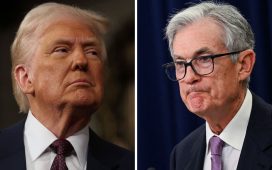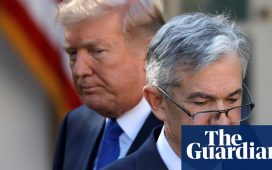Stay informed with free updates
Simply sign up to the US interest rates myFT Digest — delivered directly to your inbox.
The dollar hit a three-month low on Tuesday and US Treasury yields slid as investors grew increasingly confident that the US Federal Reserve will start cutting interest rates by mid-2024.
The US currency dropped 0.5 per cent against a basket of six peers to trade at its lowest level since mid-August.
The decline accelerated after Christopher Waller, one of the Fed’s most hawkish policymakers, signalled that interest rates were unlikely to rise further and could be cut if inflation continued to slow.
“I am increasingly confident that policy is currently well positioned to slow the economy and get inflation back to [the Fed’s target of] 2 per cent,” Waller told the American Enterprise Institute think-tank.
“If we see disinflation continuing for several more months — I don’t know how long that might be, three months, four months, five months . . . you could then start lowering the policy rate just because inflation’s lower.”
He added: “There’s just no reason to say you would keep [rates] really high and inflation is back at target, for example.”
Inflation last month fell more than expected to 3.2 per cent, compared with a peak of 9.1 per cent in June last year.
Fed chair Jay Powell said this month that the central bank was not thinking about rate cuts “now at all”.
But investors are now betting that the Fed is likely to cut interest rates as soon as May — a month earlier than pricing implied last week.
The 10-year yield on US government debt, which moves inversely to price, fell 0.04 percentage points on Tuesday to 4.35 per cent. The slide takes yields to a level last seen before September’s Fed meeting, when warnings that interest rates were going to remain higher for longer triggered a global bond rout.
The two-year yield, which is highly sensitive to interest rate expectations, fell as low as 4.75 per cent, its lowest level since August 10.
The dollar is now on course for its worst monthly performance in a year, having shed 3.6 per cent since the start of November.

Waller’s comments also come in the final days before public communications from the Fed are limited ahead of its last policy meeting of the year.
After 11 consecutive interest rate increases after March 2022, the central bank has kept its benchmark interest rate steady at a 22-year high of 5.25 per cent to 5.5 per cent since July.
The Fed is widely expected to keep rates on hold at its December meeting and Waller said US growth appeared to be moderating “as I had hoped it would, supporting continued progress on inflation”. Recent data indicated that consumer spending is slowing alongside business activity and labour demand.
In a question-and-answer session, Waller said he expected growth in the fourth quarter to moderate significantly to around 1 to 2 per cent from the faster-than-expected 4.9 per cent annualised pace registered between June and September.
But he indicated it was still too early to say definitively that the Fed had ended the rate rising cycle, since the labour market remained “fairly tight” with job creation outpacing supply.
He added that looser financial conditions — partly a function of bond market moves — also suggested a need for caution, since lower yields could offset the impact of Fed rate rises to some extent.
By contrast with Waller’s remarks, Michelle Bowman, his fellow Fed governor, said on Tuesday she still thought the central bank would probably need to increase rates further to bring inflation down in a “timely way”.
She argued that variables such as the strength of consumer spending and supply-side factors could keep inflation higher than expected, She also warned that the “neutral rate” of interest — the level that neither stimulates nor depresses the economy — may have risen in the wake of the Covid-19 pandemic.
“We should keep in mind the historical lessons and risks associated with prematurely declaring victory in the fight against inflation, including the risk that inflation may settle at a level above our 2 per cent target without further policy tightening,” Bowman said.









